
The Gyeongbu line (Gyeongbuseon) is a railway line in South Korea and is considered to be the most important and one of the oldest in the country. It was constructed in 1905, connecting Seoul with Busan via Suwon, Daejeon, and Daegu. It is by far the most heavily travelled rail line in South Korea.
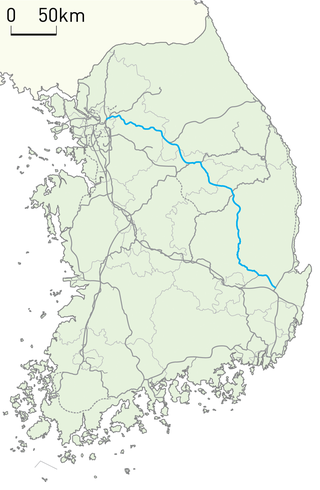
The Jungang line is a railway line connecting Cheongnyangni in Seoul to Moryang in Gyeongju in South Korea, traversing central South Korea from the northwest to the southeast. It is also referred to the rail line of the Seoul Metropolitan Subway from Yongsan station to Jipyeong station. The section from Cheongnyangni to Dodam was designated as a semi-high-speed railway.
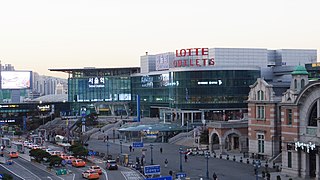
Seoul Station (Korean: 서울역) is a major railway station in Seoul, the capital of South Korea. The station is served by the Korail Intercity Lines and the commuter trains of the Seoul Metropolitan Subway.

Yongsan Station is a major railway station in the Yongsan District of Seoul, South Korea. The station adjoins the Yongsan Electronics Market. The station is the terminus for high-speed and long-distance trains on a number of railway lines, including most trains on the Honam Line, its high-speed counterpart, and all trains on the Janghang and Jeolla Lines.
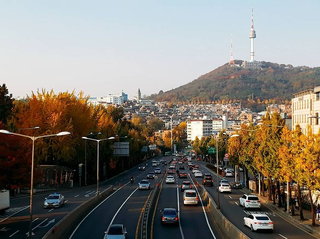
Yongsan District is one of the 25 districts of Seoul, South Korea.

Dongdaegu Station (Korean: 동대구역), meaning "East Daegu Station", is a railway station in Daegu, South Korea. It is on the national high-speed KTX railway network, 282 km (175 mi) south of Seoul Station.
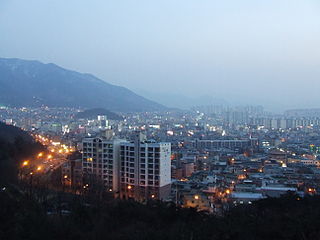
Dalseo District is a district in western Daegu, South Korea. It borders Dalseong-gun on the north, south, and west, and Seo-gu and Nam-gu on the east. It has a population of about 610,000, and an area of 62.27 square kilometers. The population rose dramatically in the 1990s, and has been approximately level since 2000.

The Mugunghwa-ho (Korean: 무궁화호) is a class of train operated by Korail, main railway operator of South Korea. Mugunghwa trains are Korail's slowest tier of trains stopping at a number of towns and villages, and operating over a number of lines that are not served by other trains. Journey times are generally twice that of KTX trains and 25% longer than ITX express trains.
Seoul, the capital and largest city in South Korea, accounts for only 0.6% of the country's total land area, yet it is home to around 19% of the population. The population density in Seoul demands a great deal of the city's transportation systems, which are regarded by many as among the best and most advanced in the world. Seoul is very well connected by its subway and bus systems, and the city is also very supportive of pedestrian foot travel. In 2006 it won the Sustainable Transport Award.

Samgakji Station is a subway station on the Line 4 and Line 6 of the Seoul Metropolitan Subway. The Seoul War Memorial is a short walk away from exits 11 and 12. This station is on the west end of the Yongsan Garrison, which is a short walk from exit 13. Although not connected to this station by a transfer passageway, Namyeong station on Line 1 is a short walk from here.

Hannam-dong (Korean: 한남동) is a dong, neighbourhood of Yongsan-gu in Seoul, South Korea. One of the most affluent neighborhoods in the country, it has been portrayed continuously in South Korea's popular culture as a wealthy and luxurious hotspot, and as a result of this reputation, the neighborhood has been the subject of numerous domestic films, television series, and popular music references.

Hangangno-dong is a dong, neighbourhood of Yongsan-gu in Seoul, South Korea.

Daegu station is a station on the Gyeongbu Line and Daegu Metro Line 1 in Chilseong-dong, Buk District, Daegu, South Korea.
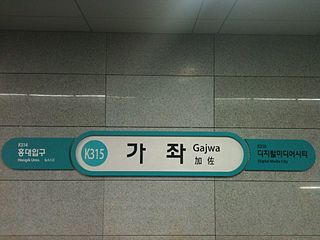
Gajwa Station is a station on the Gyeongui–Jungang Line in Seoul, South Korea.
High-speed rail service in South Korea began with the construction of a high-speed line from Seoul to Busan in 1992, and was inspired by Japan's Shinkansen. The first commercial high-speed rail service was launched on 1 April 2004. Currently, South Korea hosts two high-speed rail operators: Korea Train eXpress (KTX) and Super Rapid Train (SRT).

The Yongsan Line is a branch railroad of the Gyeongui Line, currently in service on the Gyeongui-Jungang Line. It connects Yongsan Station to Gajwa Station on the Gyeongui Line. The line was abandoned in 2005, but was reopened as an underground subway line in 2012 from Gajwa Station to Gongdeok Station and in 2014 from Gongdeok Station to Yongsan Station.

The Gyeongui–Jungang Line is a commuter rail service of the Seoul Metropolitan Subway system, operating on trackage from the Gyeongui Line and the Jungang Line.
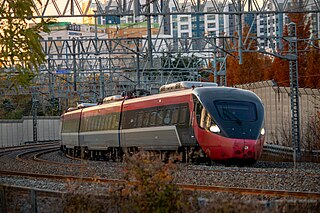
The Intercity Train eXpress-Saemaeul abbreviated as ITX-Saemaeul (Korean: ITX-새마을) is a class of train operated by Korail, the national railroad of South Korea, it was introduced on May 12, 2014, to replace the Saemaeul-ho. The new ITX-Saemaeul trains have a faster average speed of 150 kilometers per hour. The name was taken from the Saemaul Undong after a public competition to determine the new train's name.

Intercity Train eXpress-Cheongchun abbreviated as ITX-Cheongchun (Korean: ITX-청춘) is a class of train operated by Korail, the national railroad of South Korea, it was introduced on February 28, 2012. ITX-Cheongchun is the successor of the Gyeongchun Line Mugunghwa-ho which operated until December 2010. It is the only Limited express in Korea, and offers services comparable to those in Japan. In fact, it is known to benchmarking Japan's Limited express. Also, Korea's first double-decker coach was applied. This train connects Seoul, Guri, Namyangju, Gapyeong and Chuncheon. The ITX-Cheongchun trains have a faster average speed of 180 kilometers per hour.

















